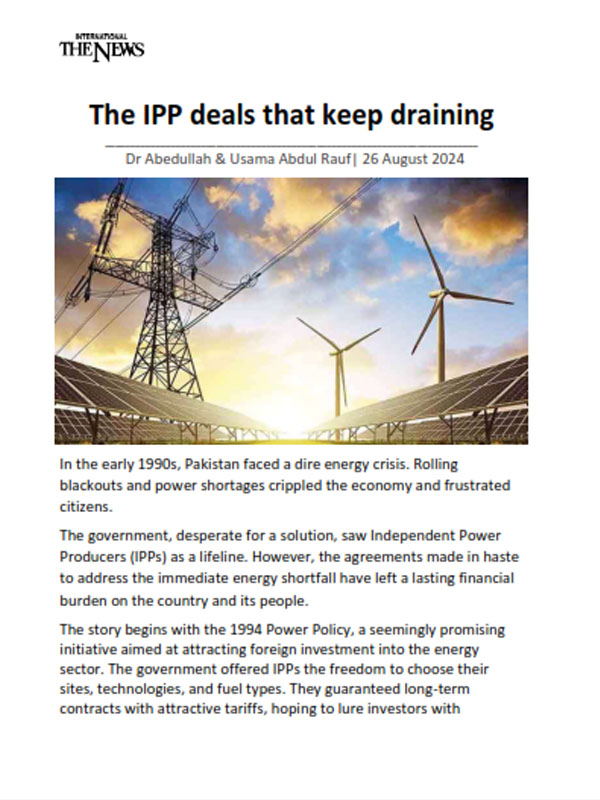
Pakistan Institute of Development Economics
- Home
Our Portals
MenuMenuMenuMenuMenuMenuMenu - ResearchMenuMenuMenuMenuMenuMenuMenu
- Discourse
- The PDR
- Our Researchers
- Academics
- Degree Verification
- Thesis Portal
- Our Portals
The IPP deals that keep draining
In the early 1990s, Pakistan faced a dire energy crisis. Rolling blackouts and power shortages crippled the economy and frustrated citizens.
The government, desperate for a solution, saw Independent Power Producers (IPPs) as a lifeline. However, the agreements made in haste to address the immediate energy shortfall have left a lasting financial burden on the country and its people.
The story begins with the 1994 Power Policy, a seemingly promising initiative aimed at attracting foreign investment into the energy sector. The government offered IPPs the freedom to choose their sites, technologies, and fuel types. They guaranteed long-term contracts with attractive tariffs, hoping to lure investors with lucrative deals. Sixteen IPPs, mostly reliant on furnace oil and gas, soon sprang up, promising a brighter future for Pakistan’s energy landscape.
But the devil was in the details. These agreements, denominated in dollars, exposed Pakistan to significant exchange rate risks. Capacity payments, which the government was obligated to make regardless of actual electricity usage, were exorbitantly high. The initial investments by these IPPs, amounting to billions, quickly turned into a financial bonanza, with returns that far outstripped their contributions.
The public, meanwhile, bore the brunt of these costs, their electricity bills soaring as a result. Due to political instability and heavy borrowing by the government during 2017-2022, the Pakistani rupee weakened by more than 100 per cent. This devaluation and increasing capacity payments in dollars pushed electricity costs to an unbearable level.
Fast forward to 2023, and the situation has only worsened. Capacity payments now account for 71 per cent of the power purchase price, leaving just 29 per cent for actual energy costs. Consumers face exorbitant bills even with minimal electricity usage. As prices soared, consumption decreased, and many shifted to solar solutions, further suppressing demand.
This shift has increased the burden of capacity payments on industries and those who cannot afford solarization. Projections for FY2024/25 paint an even grimmer picture, with capacity payments expected to surge to Rs2.8 trillion, pushing financial strain on consumers to a breaking point.
Facing an energy crisis, the government hastily entered into agreements that favoured IPPs, allowing them to dictate terms, choose sites, and bring in their technology, leaving Pakistan with little room for negotiation. The root of this issue lies in the poor capacity of the energy experts and bureaucrats involved in these deals. Hence, the government should learn how the right person for the right job can save trillions of Rupees and investment in human resources pay back in terms of high efficiency.
The government should have played the role of a facilitator and regulator, ensuring competition among IPPs to drive down costs for consumers. By providing infrastructure and letting IPPs compete, prices could have been kept in check, avoiding the heavy financial burden now placed on the public. Unfortunately, government involvement in the market process led to inefficiency, and the consequences of these flawed decisions are now painfully evident.
Developed nations learn from their mistakes and adapt. Germany, which initially invested heavily in coal but later shifted focus to renewable energy after recognizing the long-term benefits. In contrast, Pakistan’s case seems almost absurdly cyclical. The similar errors are repeated in different sectors with the expectation of different results. Is this sheer incompetence, or is there a more sinister reason behind the government’s apparent generosity towards IPPs? Why do policymakers continue to entrap the country in this vicious cycle?
These questions remain unanswered, leaving citizens to bear the brunt of misguided policies. The need of the hour is for the government to renegotiate existing IPP agreements and foster a competitive environment for green energy investments. For a stable solution in the long-run, the government should quit the energy sector and let the market work. Without these steps, the shift towards renewable energy will only shift the financial burden of capacity payments onto fewer consumers, undermining the potential benefits.
As we stand at this crossroads, it’s clear that the energy crisis of the 1990s has cast a long shadow over Pakistan’s future. The government’s decisions, driven by desperation and shortsightedness, have left the country grappling with financial stress and an inefficient energy sector.
The challenge now is not just to learn from the past mistakes but to take bold steps to correct them. Will Pakistan continue to repeat the errors of the past, or will it forge a new path toward a sustainable and economically viable energy future? The answer lies in the free market mechanism and the choices we make today.
Dr Abedullah is chief of research at the Pakistan Institute of Development Economics (PIDE). He posts/tweets as @Abedullah
Usama Abdul Rauf is a young researcher at PIDE and tweets/posts as @Usamaabdulrauf_



